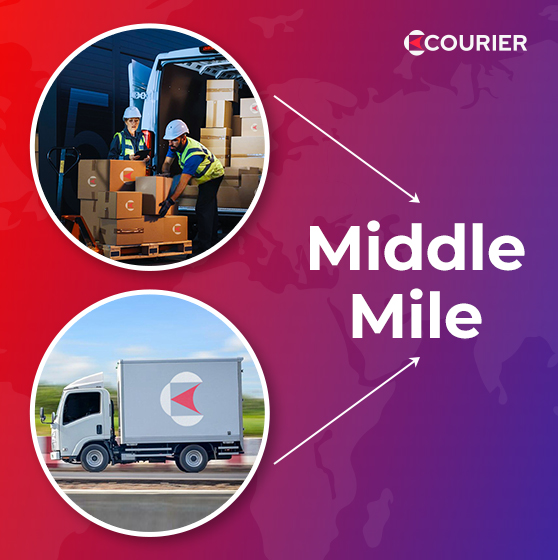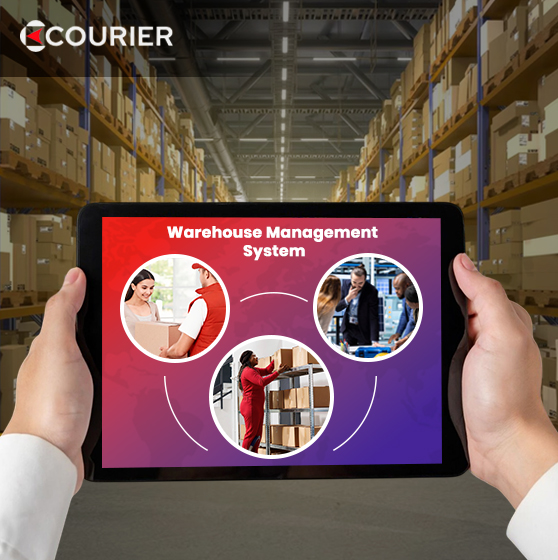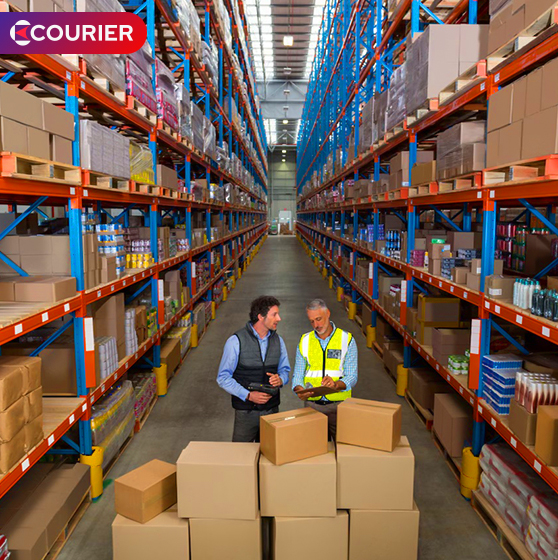
When products disappear into the “in transit” void, customers grow restless, and businesses lose visibility. But what is the problem here? A crucial yet often overlooked phase is called Middle Mile Delivery.
It is where delays, inefficiencies, and rising costs silently thrive. For logistics managers, eCommerce brands, and supply chain professionals, the middle mile is the heartbeat of fulfillment. However, it rarely gets the spotlight.
What if optimizing this one link in your supply chain could cut costs, improve speed, and boost customer satisfaction – all at once?
In this blog, we will break down what middle-mile delivery really is, how it compares to first- and last-mile logistics, and the key strategies and technologies reshaping its future. Stay tuned until the end to get answers to all your questions.
Summary: Middle mile logistics is the unsung hero of logistics. It links suppliers to distribution hubs through bulk shipments, driving speed, cost savings, and reliability. In this blog, what is middle mile delivery, how middle-mile operations compare to first and last mile, why they matter across every business trimester, and how smart technologies are revolutionizing the game.
Table of Contents
What Is Middle Mile Delivery In Logistics?
Middle-mile delivery moves goods from a supplier’s warehouse to a retail store, sorting center, or distribution hub. It connects the first mile (production or supplier facility) to the last mile (delivery to the customer). Without the middle mile, the entire supply chain system can fall apart.
If businesses want speed and efficiency, they must get the middle mile right. Middle-mile delivery carries bulk orders, not single packages. As a result, it often uses trucks, freight, or rail. For example, if a clothing brand sends 5,000 t-shirts from its factory to a distribution center, which is an example of the middle mile in action.
In terms of the trimester, the middle mile plays a critical role. In the first trimester of any supply chain cycle, suppliers plan and stock up. During the second trimester, they rely on robust middle-mile logistics to distribute goods in large quantities. Furthermore, in the third trimester, focus shifts to last-mile deliveries for customers. If the middle-mile breaks down in the second trimester, delays happen everywhere.
Retailers typically depend on smooth middle-mile operations. If a truck does not arrive at the sorting centre on time, shelves remain empty. If a grocery chain faces disruptions, fresh produce may rot before reaching stores.
Middle-mile delivery decides if products move fast or stall. If your business can master this phase, it will lower costs, increase speed, and beat the competition.
Why Middle-Mile Logistics Matters?
Middle mile delivery in the supply chain matters because it builds the bridge between supply and customer satisfaction. If companies ignore this stage, they invite delays, errors, and rising costs. Businesses lose customers when shelves stay empty, or orders arrive late. Hence, it’s possible to say that middle-mile logistics keeps everything flowing on time.
To survive in a competitive market, retailers must invest in robust middle-mile systems. This part of the chain handles bulk movement from warehouses to distribution centres or stores. It’s not flashy like last-mile delivery; however, it holds the entire operation together.
For example, when a brand launches a product in September, its second-trimester planning must rely on precise middle-mile strategies. If those goods don’t reach the sorting centre before the third trimester, the launch could fail.
Middle-mile logistics saves money if you can plan it well. Bulk transportation reduces per-unit shipping costs. Companies that control this stage cut waste, reduce fuel expenses, and improve delivery timelines. If a business uses real-time tracking or AI to optimize routes, it reduces downtime and improves coordination.
In the event of disruptions in the middle mile, they ripple across the entire supply chain. A single delay in the second trimester can push back restocking schedules and affect last-mile performance. Several businesses, including grocery stores, fashion outlets, and even e-commerce giants, will feel the pressure if trucks do not arrive on time.
Middle-mile tracking matters more than ever. The middle mile shapes how quickly and smoothly a business responds to demand. It decides whether a company meets expectations or, in turn, falls behind.
Businesses that prioritize this stage stay lean, fast, and ahead of the curve.
Key Benefits in Middle Mile Operations
Middle mile operations form the backbone of modern logistics, connecting production to distribution. They offer key benefits that drive efficiency, cut costs, and support scalable growth across every business trimester.
Check out how systematic middle mile delivery operations can benefit your business:
1. Improved Speed and Predictability
Middle mile operations increase speed and reduce guesswork. If a business wants predictable delivery cycles, it must strengthen the middle mile. Such a stage moves bulk goods from warehouses to distribution hubs, ensuring timely restocking.
For instance, in the second trimester of retail planning, demand forecasting peaks. Brands at that time relied on fast middle-mile movement to prepare stores for the third-trimester rush. Even if customer demand shifts, robust middle-mile operations enable businesses to adapt quickly.
Faster transport at this stage prevents inventory gaps and supports better sales performance downstream.
2. Cost Savings Through Bulk Movement
Efficient middle-mile shipping allows companies to move large volumes at once, which reduces per-unit costs. If a retailer ships 10,000 items in one truckload instead of sending multiple smaller loads, they save time and labour. During the first trimester, when companies lock in logistics budgets, middle-mile strategies determine how lean their operations will be.
These savings compound across quarters. Businesses can reinvest that money into improving customer service, upgrading technology, or enhancing marketing efforts. It creates a positive feedback loop that fuels future growth.
3. Enhanced Inventory Management
Strong middle-mile logistics give businesses better control over stock movement. If a company mismanages this phase, it either overstocks or understocks its inventory. Neither is ideal. Overstocking ties up cash, while understocking results in missed sales.
In the second trimester, when businesses align production with seasonal demand, middle-mile accuracy becomes critical. An efficient operation ensures the right amount of goods reaches the right hub at the right time. With this precision, companies reduce storage costs and minimise inventory losses due to expiry, obsolescence, or theft.
4. Support for Scalable Growth
Middle-mile operations create a backbone for growth. If a company wants to scale across cities or regions, it must first scale its middle mile. It’s the stage that connects production to market. Without it, even advanced last-mile systems collapse.
A fast-growing grocery brand entering new territories during its third trimester expansion plans must streamline bulk deliveries through a strong middle mile system. Without consistent movement from factories to distribution centers, store shelves remain empty, regardless of the quality of the product.
5. Space for Innovation and Automation
Middle mile operations offer a unique space for testing automation and new tech. Unlike last-mile delivery, which often faces traffic, customer-specific instructions, and doorstep variables, the middle mile follows more predictable routes.
That is why businesses now explore middle-mile drone delivery for time-sensitive or remote hub transfers. If this trend persists, it could redefine logistics in the second trimester, when distribution volume typically peaks. With innovations like AI-powered route optimisation or automated loading systems, companies gain a competitive edge within the middle mile.
Technologies Revolutionizing Middle Mile Transportation
Middle-mile transportation, in the supply chain world, is evolving fast with the rise of cutting-edge technologies. Businesses that adapt early to these changes reshape their supply chains and gain a competitive edge. If companies want to achieve resilience across all trimesters, especially during the peak second-trimester period, they must adopt these innovations.
These are the top five technologies driving this shift:
1. AI-Powered Route Optimization
Artificial Intelligence transforms how companies plan routes. Businesses utilize AI to determine the fastest and most fuel-efficient paths for middle-mile operations. If a delivery network covers hundreds of hubs, AI helps reduce idle time, driver fatigue, and delivery failures.
During the second trimester, when volume spikes, AI ensures goods move faster without raising costs. Similarly, if traffic patterns change due to weather or roadblocks, AI recalculates in real time and keeps the schedule intact.
2. Electric and Autonomous Trucks
Electric and autonomous trucks reduce fuel dependence and carbon emissions. Logistics companies invest in these technologies to improve long-term efficiency. If a fleet switches to electric vehicles in the first trimester, it saves significantly by the third trimester.
Moreover, unlike human drivers, autonomous trucks operate around the clock. Businesses that use them in mid mile logistics report fewer delays and fewer errors. Similarly, this technology supports sustainability goals without compromising speed or control.
3. Robotics and Automated Loading Systems
Warehouses now use robotics to load, sort, and dispatch goods with extreme precision. If a company handles thousands of packages daily, human effort often causes delays and errors. On the other hand, automation eliminates repetitive tasks, thereby reducing fatigue.
As a result, middle mile hubs process more freight during peak second-trimester loads. Comparable to a well-rehearsed orchestra, automated systems coordinate everything – from barcode scanning to truck loading. They do everything with flawless timing and minimal supervision.
4. IoT for Real-Time Monitoring
The Internet of Things (IoT) gives real-time visibility into shipments. Modern businesses use IoT sensors to track location, temperature, and vehicle performance. If a truck breaks down en route, alerts are sent instantly, and backup plans are activated.
Particularly when timing is crucial for success, IoT helps avoid costly delays. Food, pharma, and high-value goods stay protected under optimal conditions throughout transport. It strengthens customer trust and ensures compliance with meeting standards.
5. Drone and Aerial Delivery Trials
Some companies now explore drones for middle mile transportation over short, high-priority lanes. While still in its early stages, drone use helps reduce delays in congested urban hubs and hard-to-reach areas.
Suppose a distribution centre struggles with road closures during the third trimester holiday rush. In such cases, drones step in for fast and agile delivery. They also reduce wear and tear on ground vehicles. Although expensive now, drone technology holds long-term potential to redefine regional delivery.
Differences Between Middle Mile and First Mile Delivery
Both first mile and last mile delivery are crucial for are crucial for the smooth functioning of logistics system but there is a stark difference between. First mile delivery involves the movement of goods from the manufacturer or supplier to a central warehouse. This stage focuses on bulk transport and supplier coordination. In contrast, last mile delivery is the final leg, delivering products from a distribution hub to the end customer. The last stage prioritizes mainly speed, accuracy, and customer experience.
However, middle mile delivery differs from first mile in a range of aspects. Understanding the key differences between middle mile and first mile delivery is essential for building a strong, responsive supply chain. If your business mismanages either stage, it risks delays and rising costs across all trimesters of operation.
We have jotted down the differences we have observed in between middle mile and last mile in the below points:
1. Origin Points and Shipment Purpose
First-mile delivery starts at the source, such as factories, farms, or suppliers. It then moves goods to a warehouse or distribution center. In contrast, middle mile shifts those goods from that storage point to a retailer or hub. If a company enters its first trimester and focuses on sourcing raw materials, first-mile logistics defines success.
On the other hand, the middle mile takes over during the second trimester, when bulk movement requires precision and planning. Contrary to the last mile delivery, these two phases handle upstream tasks that set the tone for final delivery.
2. Transport Volume and Coordination Needs
The first mile deals with high variability, often transporting raw or unfinished goods. The middle mile handles finished products in bulk, utilizing planned, recurring routes. Suppose a business sources materials from multiple suppliers in the first trimester. In that case, the first mile becomes chaotic and coordination-heavy.
However, the middle mile stabilises this flow by grouping, routing, and dispatching those goods toward demand zones. So, while both deal with scale, the middle mile demands more route consistency and less supplier juggling.
3. Visibility Challenges and Data Gaps
Companies often struggle to track shipments in the first mile due to fragmented supplier networks and limited tech adoption. In contrast, middle mile operations usually involve more structured partners, making tracking smoother.
During the second trimester restocking, middle-mile systems offer real-time status updates. But if the first mile lacks integration, it disrupts downstream planning.
Although all stages, including first-, middle-, and last-mile delivery, require visibility, early-stage gaps often impact everything that follows. Bottom of Form
Differences Between Middle Mile and Last Mile Delivery
First, middle, and last mile delivery – each serves a unique role in logistics. If businesses want smoother supply chains across all trimesters, they must understand the middle mile vs last mile debate. Below, we have presented a well-researched set of differences between the two:
1. Purpose and Delivery Scope
The key difference between mid-mile and last mile lies in their purpose and scale. The middle mile connects suppliers to distribution hubs or retail outlets, often in bulk. Meanwhile, the last mile delivers individual packages to end customers.
If a brand ships goods during the second trimester to prepare for seasonal demand, the middle mile manages massive volumes. On the contrary, the last mile ensures final doorstep delivery. Unlike the last mile’s scattered drop points, the middle mile deals with fewer, more centralised locations.
2. Cost Dynamics and Operational Pressure
The middle mile focuses on cost efficiency through consolidated shipments and scheduled routes. The last mile, however, faces unpredictable traffic, high delivery expectations, and scattered destinations, making it more expensive per unit.
Suppose a company handles its middle mile in the first trimester using full truckloads; it saves a significant amount. However, if it fails to manage the last mile in the third trimester, costs skyrocket due to increased urgency, returns, and failed deliveries.
Each phase presents its challenges, but the last mile faces even greater pressure from customer-facing expectations.
3. Technology and Resource Requirements
Middle mile benefits from route optimization software, warehouse automation, and bulk tracking systems. These tools are essential for efficient restocking, especially during high-demand periods such as a second-trimester product launch. To ensure smooth operations, businesses must fine-tune their middle mile strategies early on.
But what does last mile delivery mean in this context? It’s the final step that gets products from distribution hubs to the customer’s doorstep, thereby, requiring a different tech stack. Last mile operations rely more on mobile apps, GPS tracking, and flexible delivery solutions. Moreover, customer-centric features such as live tracking and real-time communication are critical here.
While both stages depend on technology, they solve distinct challenges like bulk movement versus personalized delivery.
Key Challenges Facing Middle-Mile Logistics
Middle-mile logistics faces tough, fast-changing challenges that directly impact delivery speed, cost, and coordination.
If you overlook these obstacles, especially during high-volume trimesters, you risk delays, rising expenses, and lost customer trust:
1. Lack of Real-Time Visibility
Visibility gaps weaken control in the middle mile in logistics. If companies can’t track shipments in real time, they risk delays, errors, and damaged trust. During the second trimester, when bulk movement spikes, blind spots create chaos.
At the same time, without live updates, teams struggle to react to disruptions or reroute efficiently.
2. Rising Fuel and Operational Costs
Fuel prices and operational costs continue to climb, which tightens the profit margins. If businesses don’t optimize routes in the first trimester, expenses soar by the third.
Moreover, fluctuating toll fees, labour charges, and equipment maintenance cause a sharp strain on the budgets. As a result, companies must constantly adjust financial planning and resource allocation.
3. Infrastructure and Traffic Bottlenecks
Ageing roads, limited loading docks, and traffic congestion stall middle-mile transport. Suppose a truck carries essential inventory during the second-trimester peak and hits roadblocks. It will delay the entire supply chain.
Even smart planning can fail when poor infrastructure slows down otherwise optimised operations, forcing businesses to rethink their routing.
4. Labour Shortages and Driver Fatigue
Logistics suffers when companies can’t find or retain skilled drivers. If workforce shortages hit in the third trimester, delivery schedules are going to collapse under pressure.
Additionally, long hauls during middle-mile trips lead to fatigue. It increases the risk of accidents, poor performance, or late arrivals – none of this is something a business can afford.
5. Complex Coordination Between Partners
Managing multiple vendors, warehouses, and carriers requires seamless coordination and synchronization to ensure efficient operations. However, if communication breaks down during the second trimester, bulk deliveries go astray.
Similarly, mismatches in schedules between distribution hubs and suppliers result in costly delays and missed timelines. And friction between key partners in the supply chain.
Strategies to Optimize Middle-Mile Operations
Optimizing middle mile delivery helps businesses boost speed, reduce costs, and stay agile across trimesters. If you apply these strategies, it would turn this often-overlooked stage into a powerful logistics advantage.
Take a look at our expert strategies below:
1. Leverage Data for Smarter Planning
Nowadays, efficient companies utilize data analytics to forecast demand and optimize delivery routes. If businesses analyze previous trimester patterns, they predict upcoming volume surges more accurately.
Correspondingly, predictive insights help reduce idle time, missed stops, and excess inventory, especially during the second-trimester peak loads.
2. Consolidate Shipments Strategically
B2B retail fulfillment services optimize space and reduce trips by consolidating goods into fewer, fuller shipments. Assumingly, a business bundles inventory in the first trimester to prepare for third-trimester promotions.
In that case, they cut fuel use, streamline scheduling, and lower handling costs while ensuring steady product flow to hubs.
3. Embrace Flexible Transportation Models
Dynamic route planning and multi-modal transport improve reliability. If a truck route faces delays in the second trimester, companies shift to rail or air without halting movement.
Flexible models enable rerouting mid-journey, providing operations with the flexibility to adapt quickly to changing conditions.
4. Strengthen Collaboration Across the Chain
Effective middle-mile operations depend on seamless teamwork between suppliers, carriers, and distribution centres. If communication breaks down during trimester transitions, shipments get delayed or misrouted.
Oppositely, shared dashboards and real-time updates align stakeholders and improve speed, accuracy, and decision-making under pressure.
5. Invest in Automation and Tech Integration
Smart tools, including automated loading, IoT sensors, and fleet management software, boost efficiency without requiring additional manpower. Take, for instance, a second-trimester warehouse using robotics for truck loading.
It moves faster, reduces human error, and frees up resources for more strategic logistics efforts downstream.
Strengthen Your Supply Chain with Our Smarter Middle Mile Solutions
In today’s fast-paced logistics environment, every mile matters. From sourcing materials in the first mile to bridging bulk movement in the middle mile delivery stage, and finally reaching customers through the last mile, each phase plays a vital role in shaping efficiency, cost, and customer satisfaction.
However, it’s the middle mile that quietly drives the rhythm of operations across trimesters. If this stage falters, even the most efficient first mile sourcing or polished last-mile strategies can collapse under pressure.
To build resilience, your business must focus on adopting technologies and optimizing routes. You must also take all necessary measures to strengthen coordination across the entire chain of first-mile, middle-mile, and last-mile logistics.
Ready to streamline your courier operations?
Let Courier Platform help you take control of your middle mile today. Get in touch to unlock smarter logistics, faster deliveries, and a stronger supply chain.
Recent Posts





 25th September , 2025
25th September , 2025 





